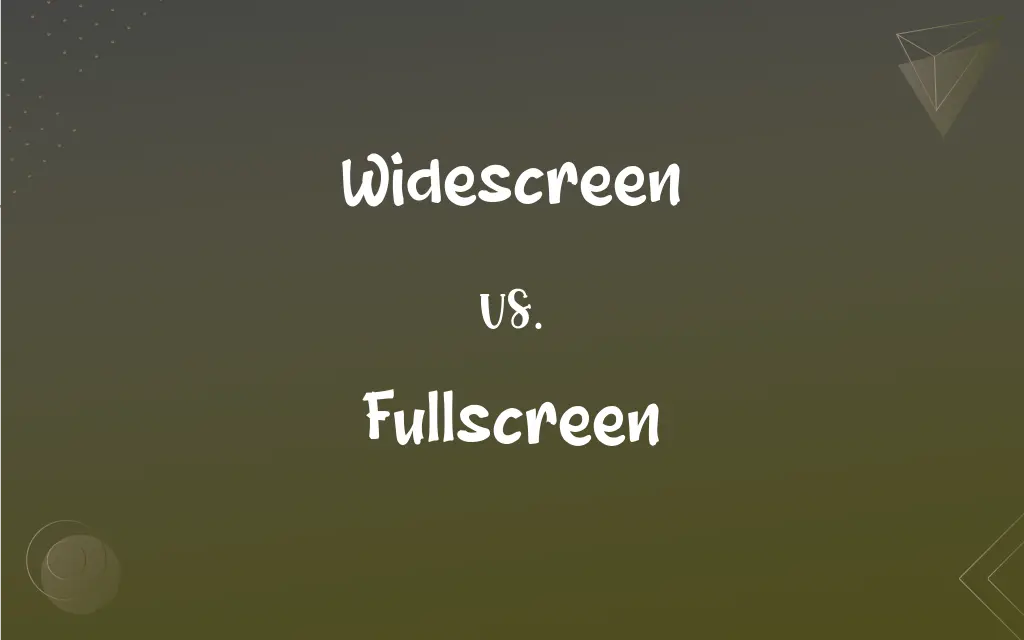Widescreen vs. Fullscreen: What's the Difference?
Edited by Aimie Carlson || By Harlon Moss || Published on December 17, 2023
Widescreen refers to a wider aspect ratio (typically 16:9), offering a broader field of view, while fullscreen usually refers to a 4:3 aspect ratio, fitting traditional TV screens without side bars.

Key Differences
Widescreen formats typically have an aspect ratio of 16:9, providing a more immersive visual experience with a wider field of view, ideal for cinematic content. Fullscreen, with a 4:3 aspect ratio, offers a more squared visual field, common in older television broadcasts and some standard definition content.
Widescreen is the standard for most modern TVs, monitors, and digital content, accommodating the wide aspect ratio of most films and HD content. Fullscreen is more compatible with older televisions and content, often resulting in "letterboxing" when played on widescreen displays.
When adapting widescreen content for fullscreen display, cropping or "pan and scan" techniques are often used, which can lead to loss of peripheral visual information. Conversely, displaying fullscreen content on a widescreen display may result in black bars on the sides, known as "pillarboxing."
Widescreen is preferred for a more cinematic and expansive viewing experience, especially for movies and modern video games. Fullscreen may be favored for certain types of older media or by those accustomed to traditional TV formats.
The widescreen format influences media production, encouraging wider shots and panoramic views. Fullscreen format, however, demands a different approach, focusing on central framing and less on wide-angle perspectives.
ADVERTISEMENT
Comparison Chart
Aspect Ratio
Typically 16:9
Traditionally 4:3
Visual Field
Wider and more cinematic
More square, fitting older TV screens
Content Adaptation
May result in letterboxing on 4:3 screens
Can lead to cropping on 16:9 screens
Preferred Use
Modern films, HD content, video games
Older television broadcasts, standard definition content
Production Considerations
Wider shots, panoramic scenes
Central framing, less emphasis on width
ADVERTISEMENT
Widescreen and Fullscreen Definitions
Widescreen
A display format with a wide aspect ratio, typically 16:9.
The widescreen TV provided an immersive experience for watching epic movies.
Fullscreen
A standard television and video format, more square than widescreen.
Classic TV shows are often shown in fullscreen, reflecting their original broadcast format.
Widescreen
A display aspect ratio broader than traditional television screens.
Upgrading to a widescreen monitor significantly improved her computer usage experience.
Fullscreen
A display format with a traditional 4:3 aspect ratio.
The fullscreen version of the movie fit perfectly on her old television set.
Widescreen
A format used for most modern televisions and computer monitors.
The widescreen format has become the standard for high-definition video content.
Fullscreen
A screen aspect ratio that matches the traditional television and computer monitors.
Fullscreen games from the early 2000s often don't translate well to modern widescreen displays.
Widescreen
A film or video format that extends the field of view horizontally.
The widescreen version of the film showcased stunning landscape scenes.
Fullscreen
A video or image format that fills the entire screen of standard TVs without letterboxing.
Watching the fullscreen version meant some of the scene's details were cropped out.
Widescreen
A wider than standard screen format, enhancing cinematic visuals.
Many modern video games are designed for widescreen to enhance gameplay visuals.
Fullscreen
A format used predominantly before the adoption of widescreen.
He preferred the fullscreen format for its nostalgic feel when watching older movies.
Widescreen
Of or relating to a display screen or an image with a width-to-height ratio greater than 4:3 and a typical ratio of 16:9.
Fullscreen
To make a window occupy the entire screen.
Widescreen
A screen with a wider aspect ratio than the ordinary 35-millimeter frame, making more effective use of the human field of view and producing a more immersive view experience.
Widescreen
(film) Filmed in a greater aspect ratio than the 1.33:1 or 1.37:1 aspect ratio.
Widescreen
(of a motion picture) Presented in the original aspect ratio; presented in letterbox orientation.
FAQs
Why is widescreen preferred for modern content?
Widescreen is preferred for its more cinematic and expansive visual experience, fitting most modern films and HD content.
When is fullscreen format used?
Fullscreen is used for older television broadcasts and standard definition content that was produced in a 4:3 aspect ratio.
How does fullscreen differ from widescreen?
Fullscreen refers to a 4:3 aspect ratio, more square compared to the wider 16:9 aspect ratio of widescreen.
What is widescreen?
Widescreen is a display format with a wider aspect ratio, typically 16:9, offering a broader field of view.
Do widescreen and fullscreen affect the viewing experience?
Yes, widescreen offers a more immersive experience, while fullscreen may feel more restricted but suits certain content types.
Can widescreen content be adapted to fullscreen?
Yes, but it often requires cropping or "pan and scan," which can lead to loss of some visual information.
Do DVDs offer both widescreen and fullscreen versions?
Many DVDs offer both versions, allowing viewers to choose based on their preference and screen type.
What happens when fullscreen content is displayed on widescreen?
Fullscreen content on widescreen displays often results in black bars on the sides, a phenomenon known as "pillarboxing."
Are movies filmed differently for widescreen?
Yes, movies filmed for widescreen often use wider shots and panoramic views to take advantage of the format.
Is widescreen better for video games?
Widescreen is generally preferred for modern video games due to its wider field of view and more immersive gameplay experience.
Why was fullscreen popular in the past?
Fullscreen was the standard format for older televisions and media, reflecting the technology and production styles of the time.
Can you convert widescreen content to fullscreen without quality loss?
Conversion can result in quality loss, especially if important visual information is cropped out.
Do modern TVs support both widescreen and fullscreen?
Yes, modern TVs generally support both formats, though fullscreen content may have pillarboxing on widescreen TVs.
How do filmmakers decide on the format?
Filmmakers choose the format based on artistic vision, content type, and the intended audience experience.
Has widescreen become the industry standard?
Yes, widescreen has become the standard, especially with the prevalence of HD and digital content.
Are there any visual drawbacks to widescreen?
On widescreen, some content may appear stretched or distorted if not originally produced in a widescreen format.
What should consumers consider when choosing between widescreen and fullscreen?
Consumers should consider the type of content they watch most and the compatibility with their display devices.
How does aspect ratio affect widescreen and fullscreen?
Aspect ratio is the key difference; widescreen has a wider, more rectangular shape (16:9), while fullscreen is squarer (4:3).
Can aspect ratios vary within widescreen formats?
Yes, there can be variations like ultra-widescreen formats, but 16:9 is the most common.
Is one format better than the other for certain types of content?
Widescreen is better for cinematic content, while fullscreen may be preferred for older TV shows and some classic films.
About Author
Written by
Harlon MossHarlon is a seasoned quality moderator and accomplished content writer for Difference Wiki. An alumnus of the prestigious University of California, he earned his degree in Computer Science. Leveraging his academic background, Harlon brings a meticulous and informed perspective to his work, ensuring content accuracy and excellence.
Edited by
Aimie CarlsonAimie Carlson, holding a master's degree in English literature, is a fervent English language enthusiast. She lends her writing talents to Difference Wiki, a prominent website that specializes in comparisons, offering readers insightful analyses that both captivate and inform.































































